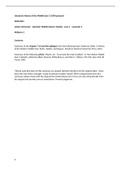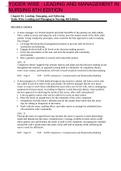Samenvatting
Summary literature History of the Middle East (1500-present) midterm 2 (final exam)
- Instelling
- Universiteit Leiden (UL)
A complete and comprehensive summary of the literature for the 2nd (final) midterm of the subject History of the Middle East (1500-present). Exam grade: 8,0. It contains an elaborate summary of chapters 7-10 and the epilogue of the book: Anderson, Betty. A History of the Modern Middle East:...
[Meer zien]















